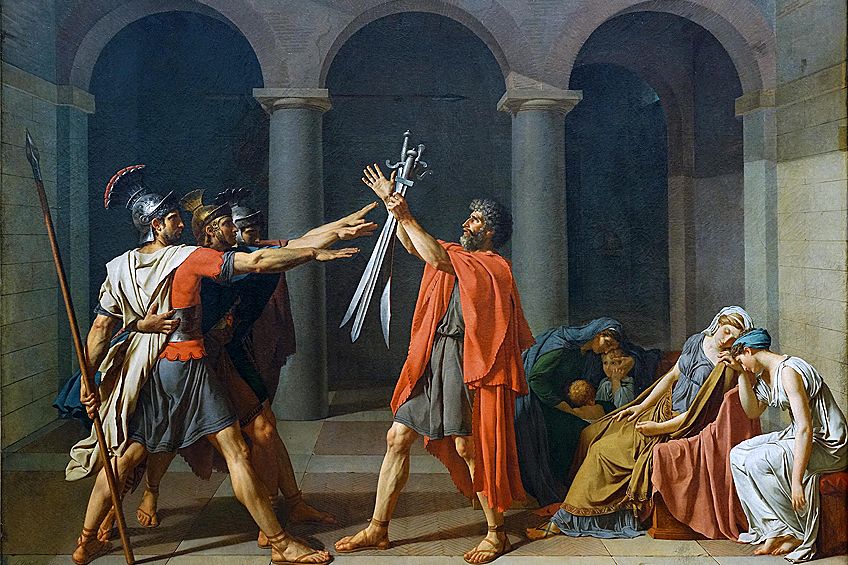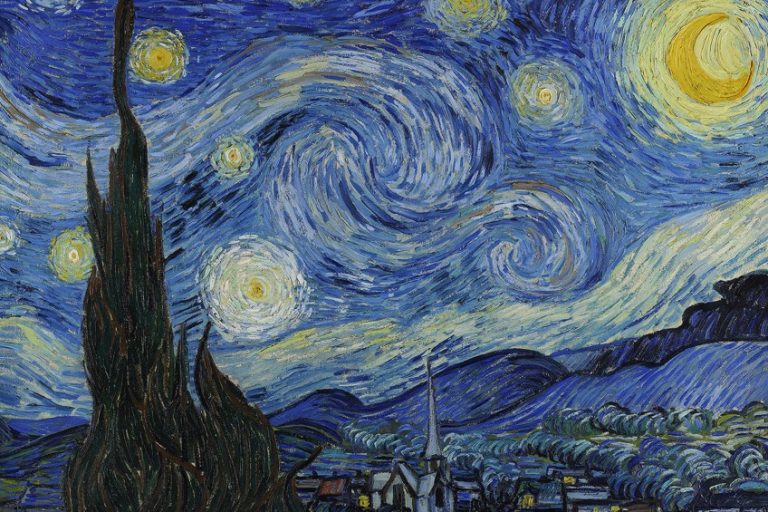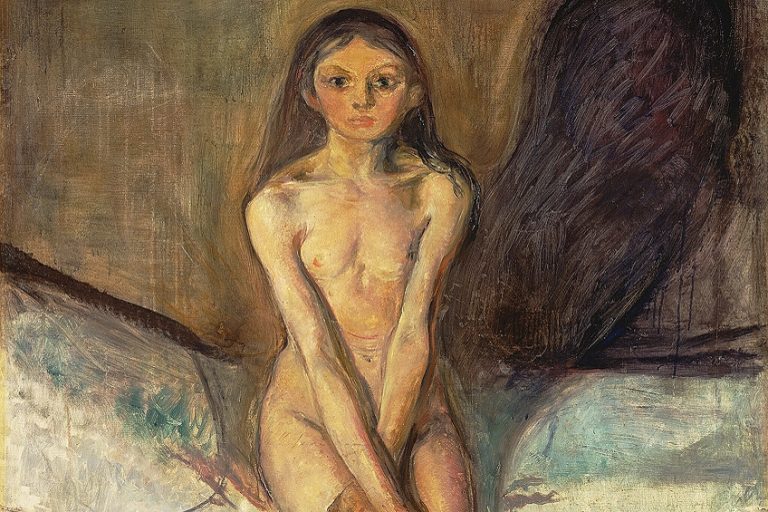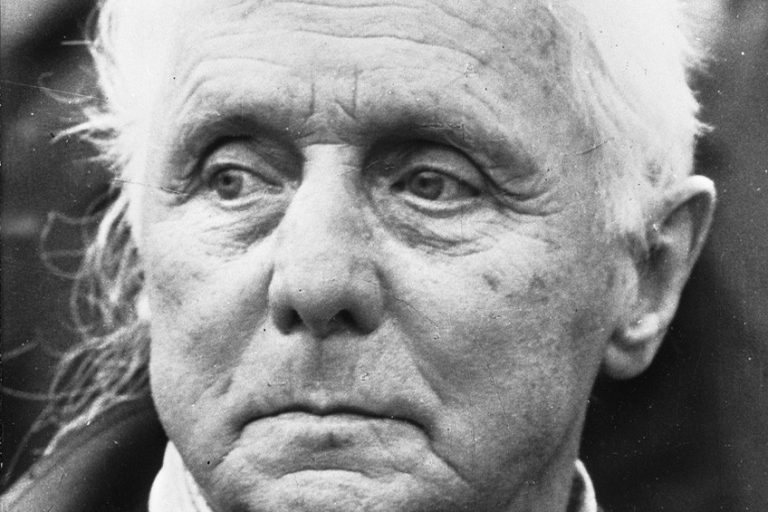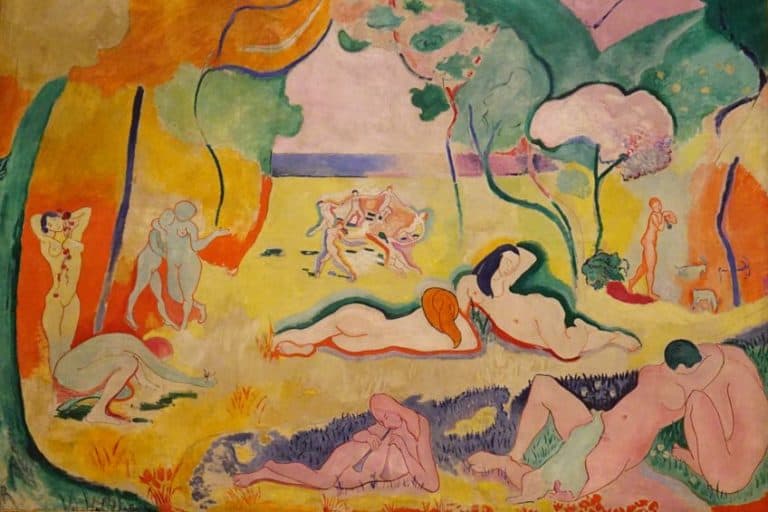“Oath of the Horatii” by Jacques-Louis David – An In-Depth Analysis
If you enjoy Neoclassical art, then Oath of the Horatii (1784) by Jacques-Louis David is a staple in your art history knowledge bank. But what makes this such a significant history painting? This article will explore this question and more in the Oath of the Horatii analysis.
Table of Contents
Artist Abstract: Who Was Jacques-Louis David?
Jacques-Louis David was a French Neoclassical artist, his date of birth was August 30, 1748, and his death was December 29, 1825. His place of birth was Paris, France, but he lived out his last days to his death in Brussels in Belgium. His artistic training included teachers like François Boucher and Joseph-Marie Vien, and he also studied at the Royal Academy of Painting and Sculpture.
He also won the Prix de Rome in 1774 and traveled to Italy where he learned about classical masters like Caravaggio and Nicolas Poussin.
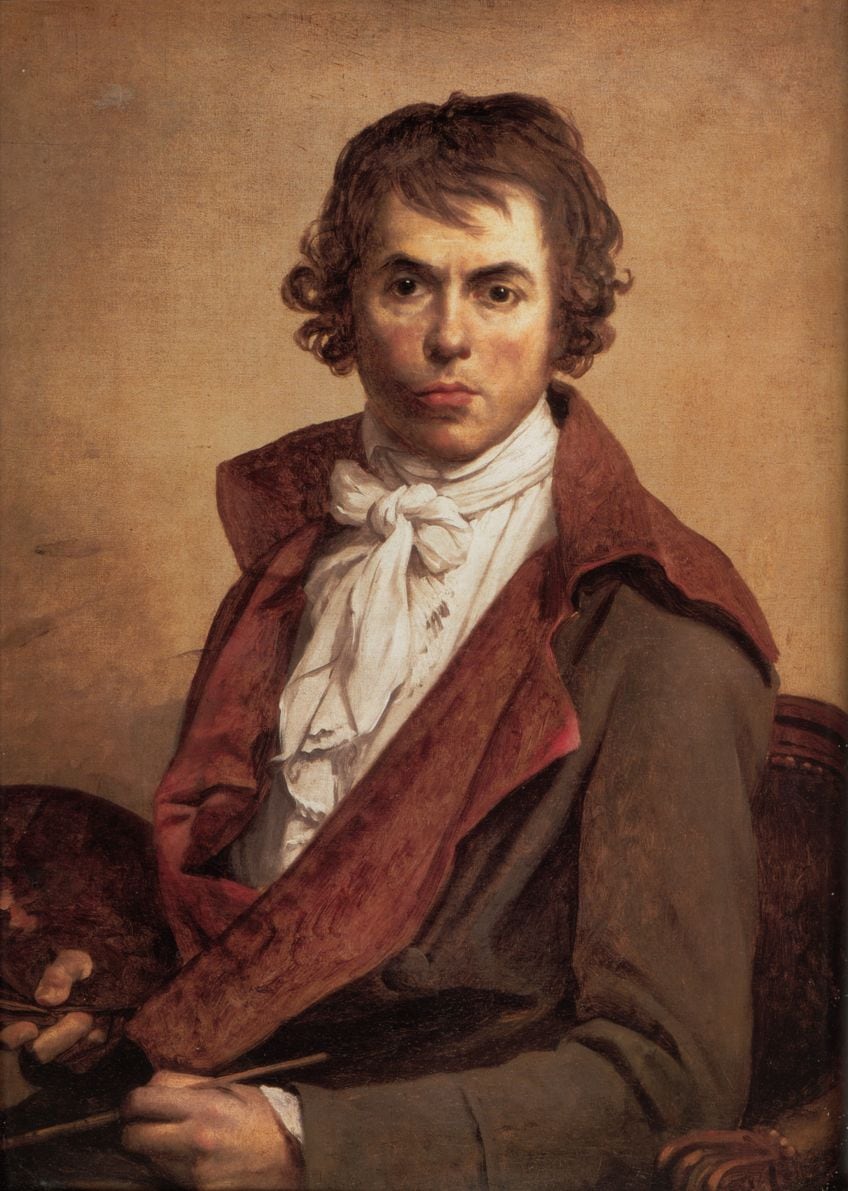
His penchant for classical art was also catalyzed by his exposure to the Pompeii ruins that were unearthed in 1748. Among David’s significant artworks is The Death of Socrates (1787), The Lictors Returning to Brutus the Bodies of His Sons (1789), The Death of Marat (1793), and Napoleon Crossing the Alps (1805).
Oath of the Horatii (1784) by Jacques-Louis David in Context
In the article to follow you will learn more about the prominent and popular Neoclassical painting Oath of the Horatii by Jacques-Louis David and why he painted it along with a formal analysis that will discuss the artistic characteristics according to the art elements and principles.
| Artist | Jacques-Louis David (1748 – 1825) |
| Date Painted | 1784 |
| Medium | Oil on canvas |
| Genre | History painting |
| Period / Movement | Neoclassicism |
| Dimensions (cm) | 329.8 x 424.8 |
| Series / Versions | N/A |
| Where Is It Housed? | Musée du Louvre, Paris, France |
| What It Is Worth | N/A |
Contextual Analysis: A Brief Socio-Historical Overview
The oil on canvas Oath of the Horatii by Jacques-Louis David was painted in 1784 and was commissioned by Charles-Claude de Flahaut de la Billarderie, who worked for King Charles Louis XVI, and he was the head of the Bâtiments du Roi, which is translated from French as the “King’s Household”.

Charles-Claude de Flahaut de la Billarderie wanted the painting to symbolize loyalty, especially to the royal kingdom, but David’s portrayal of it depicted a different type of loyalty, which represented loyalty to the Republic, and so it went against royalty – many sources have described this commission as backfiring from its original intention.
The painting was also created around five years before the French Revolution and charged with political ideals of transformation and ultimately revolution. It also depicts David’s own political views.
Who Were the Horatii?
You might be wondering who the Horatii were. They were Roman “triplet brothers”, and written about by the Roman historian Titus Livius, who is better known as Livy. He wrote about the brothers in his publication known as “Livy 1”. The Horatii brothers were meant to fight the Curiatii brothers, who were from Alba Longa. However, to make a long story short, there were also ties between one of the women depicted, namely Camilla who was reportedly engaged or married to one of the Curiatii brothers while being the other Horatii sibling, or sister to her three brothers.
The other woman was also reportedly married to one of the Horatius brothers and from the Curatius family. Therefore, it also explains why the women appear anguished in the Oath of the Horatii painting.
Formal Analysis: A Brief Compositional Overview
The formal analysis will take a closer look at Jacques-Louis David’s Neoclassical painting Oath of the Horatii, its subject matter, and artistic techniques utilized and applied by the artist according to the criteria of the art elements and principles, which also aims to highlight how this painting is exemplary of the Neoclassical ideals.
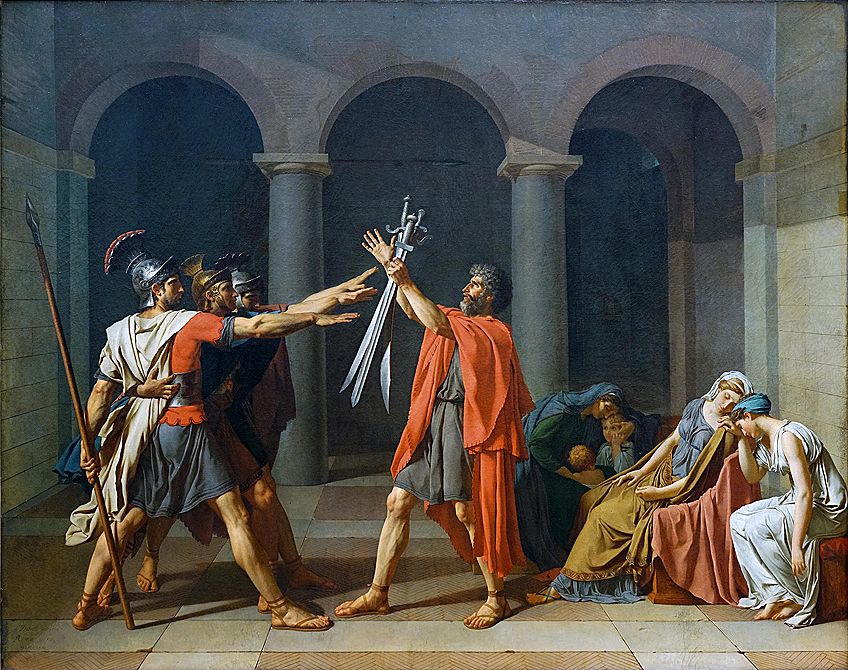
Subject Matter: Visual Description
The Oath of the Horatii by Jacques-Louis David takes place in an interior setting, which has been described as possibly an atrium. This is part of Roman architecture and is characterized by having a skylight instead of a roof, almost like an indoor courtyard, so to say. In the foreground are three groups of figures, from the left, are the three Horatii brothers standing close next to one another in power poses, their legs are wide apart, and their feet are planted on the tiled floor.
Each has an arm outstretched straight in front of them with the palms of their hands facing the floor. The middle brother has his other arm around the waist of the brother closest to us in the foreground, the latter grips a long spear in his left hand held behind his back.
The central figure in the foreground is the Horatii brothers’ father, he is holding up three swords in his left hand while his right hand appears empty but also held up displaying somewhat splayed fingers.
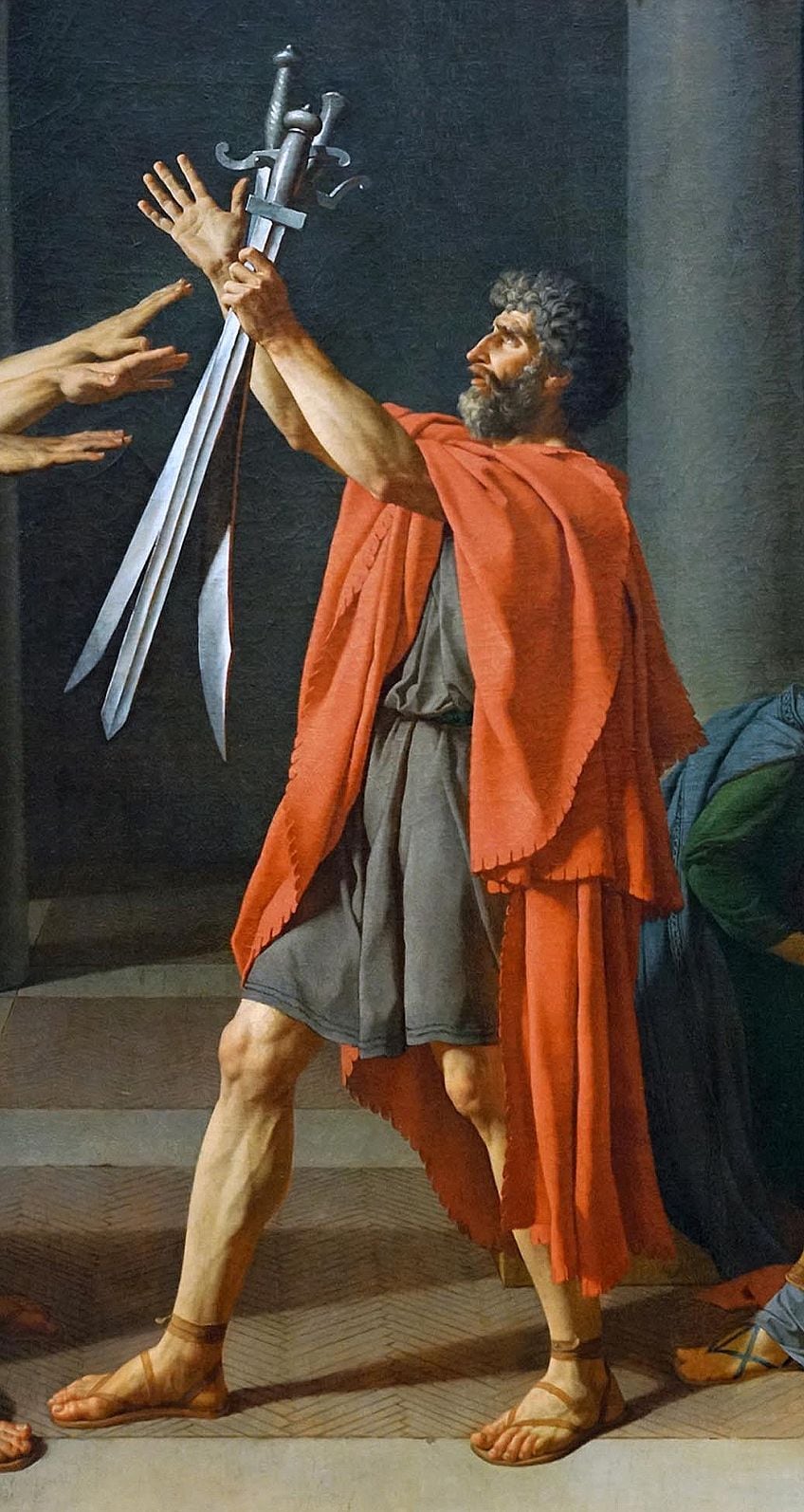
He is also standing in a power pose with his right leg in front of him, almost touching his son’s feet, and his leg is behind him. His body posture is slightly bent backward, and he appears to have an upward gaze while his three sons stand in a salute towards the swords. The group to the right depicts three women and two children, contrasting the men’s poses, they are all seated and appear saddened, almost consoling each other because they undoubtedly know what is about to take place between the Horatti and Curiatii.
The background is a neutral space, appearing darker and shadowed compared to the foreground. It consists of three arches lining it too, each corresponding to and highlighting the three groups of figures in the foreground.
Color
The color scheme is subdued in Oath of the Horatii by Jacques-Louis David, depicting somewhat muted reds, blues, mustardy-brown/beige, off whites, but also deeper shades of blue and green, and golds and silver for the swords and helmets. David also depicted a beautiful contrast between light and dark, as previously mentioned, the background is in darker shadows compared to the foreground, which is lit up by an unknown light source possibly coming from the left, illuminating all the figures as well as casting the men’s shadows and the wall on the right.
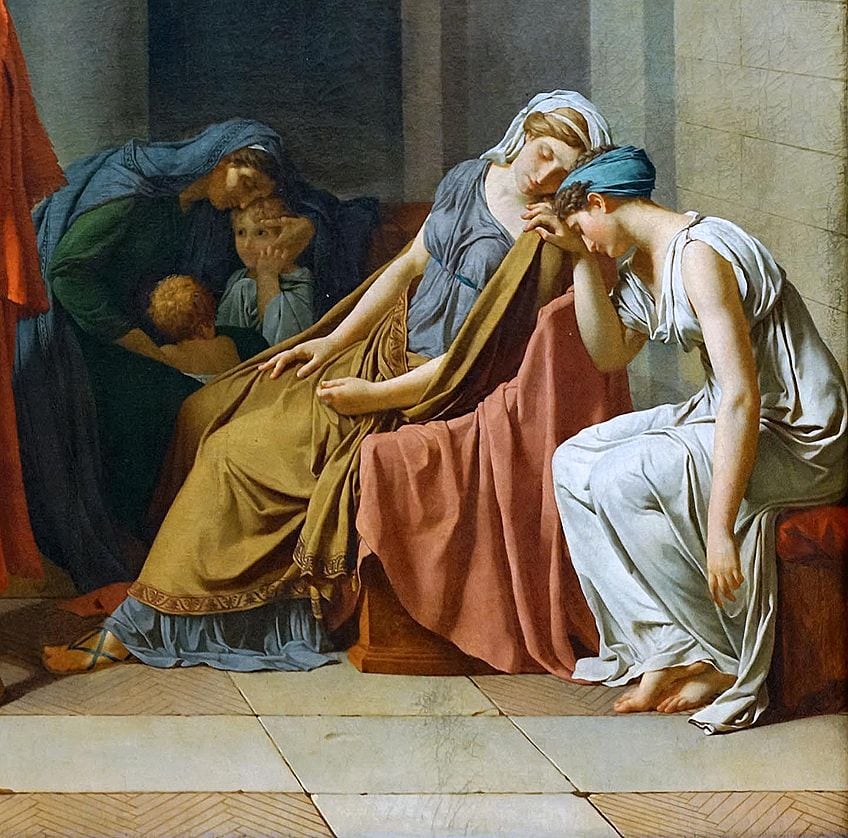
Line
There is an interplay of lines in Oath of the Horatii, specifically between curved and straight lines. The straight lines are evident in the men’s upright and often-described “rigid” postures, more specifically, the horizontal lines created by their outstretched arms, the diagonal lines created from the legs, and the straight vertical lines implied by the swords, spears, and importantly the three vertical columns in the background.
The curved lines are evident in the arches in the background as well as in the women, whose postures are more fluid and languid.
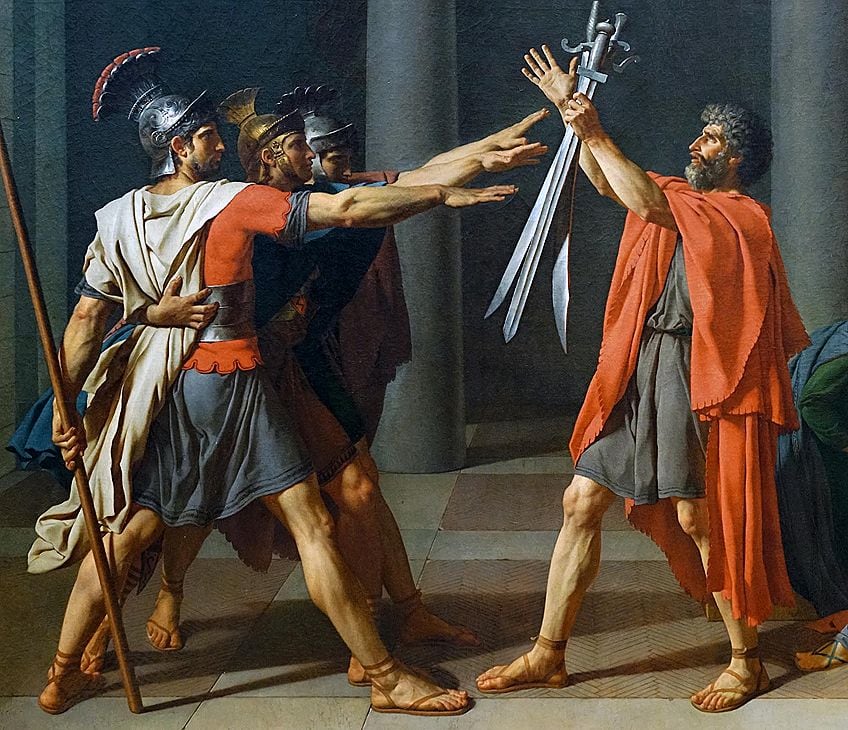
Texture
As is characteristic of Jacques-Louis David’s Neoclassical art style, his brushstrokes are seldomly (almost never) evident, and he applied paint in smooth and clean strokes. There is also implied texture, notably in the various softer folds of the clothing, which is contrasted with the hardness of the interior space’s brick walls, columns and arches, and tiled floor.
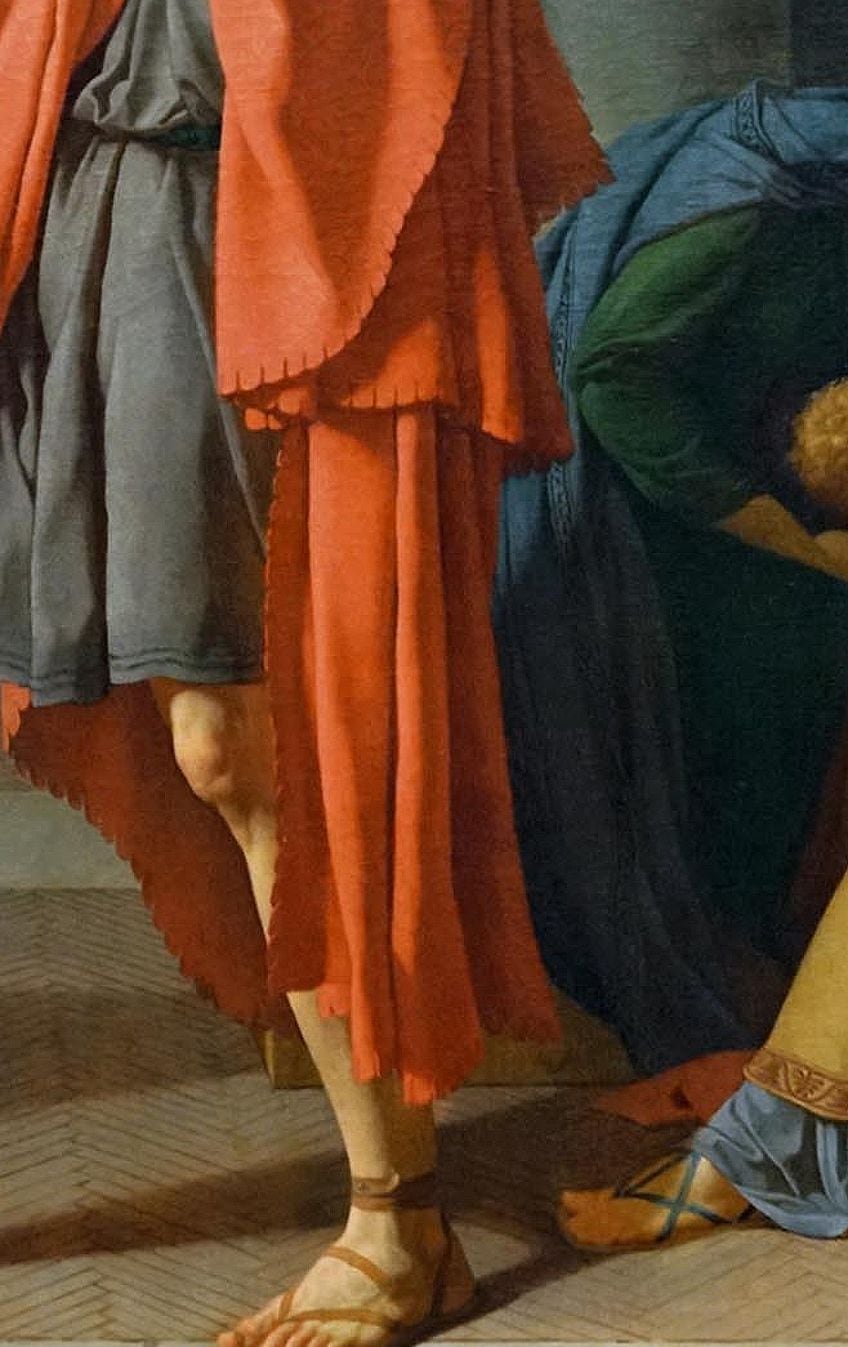
Space
The compositional space is composed of the foreground, where all the primary figures are placed, the narrative takes place and the background is depicted as an empty dark space, which further places emphasis on the foreground.
Furthermore, when looking at the perspective of the scene, David created the focal point at the father’s hand holding the three swords, which acts as the vanishing point and furthermore creates the viewer’s line of sight, emphasizing the main focal point and narrative.

Shape and Form
The Oath of the Horatii follows naturalistic forms, notably in the figures, for example, the men appear athletic and muscular, and the women appear more curvaceous. The natural forms are contrasted by the geometric shapes of the architecture, for example, the cylindrical columns and the semi-circular curves of the arches.
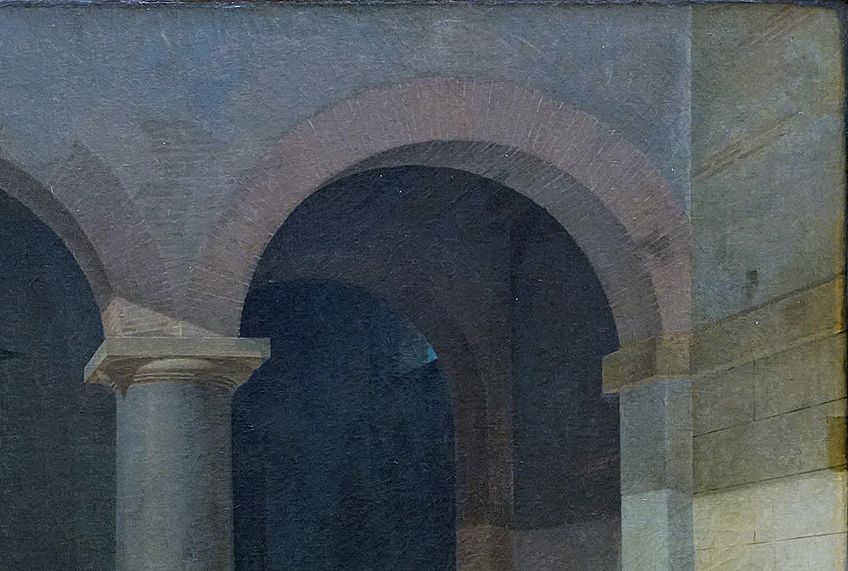
More than a Roman Oath
This article discussed the Oath of the Horatii analysis, which was painted by one of the foremost Neoclassical artists Jacques-Louis David. It explored why he painted it as well as his stylistic approach that has made it exemplary of Neoclassical art.
David reportedly exhibited Oath of the Horatii in Rome and then at the famed Paris Salon in 1785. Furthermore, some sources suggest the inspiration for the compositional subject matter of the brothers taking the oath with the three swords was believed to have come from Horace (1640) by Pierre Corneille.
The Oath of the Horatii by Jacques-Louis David has been described as an indirect propagandist painting of its time, portraying ideals like heroism, loyalty, patriotism, and ultimately uprising. It is almost like a visual beckoning and precursor to the French Revolution and the changes it catalyzed within France, in which David was an active agent too. It is French blood and fortitude envisioned through a Roman oath.
Take a look at our Oath of the Horatii painting webstory here!
Frequently Asked Questions
Who Painted Oath of the Horatii?
The French Neoclassical artist Jacques-Louis David painted Oath of the Horatii (1784), which is a life-size oil on canvas, measuring 329.8 x 424.8 centimeters. It portrays the historical story of the Roman Horatii brothers pledging an oath to their father before their fight with the Curiatii brothers from the rival city of Alba Longa.
Where Is the Neoclassical Painting Oath of the Horatii Housed?
Oath of the Horatii (1784) by Jacques-Louis David is at the Musée du Louvre in Paris, France. It previously belonged to King Louis XVI’s collection.
What Does the Neoclassical Painting Oath of the Horatii Mean?
The Oath of the Horatii (1784) by Jacques-Louis David is a Neoclassical painting depicting a 7th-century Roman story. It symbolizes the so-called ideas of heroism, patriotism, masculinity, and sacrifice.
Alicia du Plessis is a multidisciplinary writer. She completed her Bachelor of Arts degree, majoring in Art History and Classical Civilization, as well as two Honors, namely, in Art History and Education and Development, at the University of KwaZulu-Natal, South Africa. For her main Honors project in Art History, she explored perceptions of the San Bushmen’s identity and the concept of the “Other”. She has also looked at the use of photography in art and how it has been used to portray people’s lives.
Alicia’s other areas of interest in Art History include the process of writing about Art History and how to analyze paintings. Some of her favorite art movements include Impressionism and German Expressionism. She is yet to complete her Masters in Art History (she would like to do this abroad in Europe) having given it some time to first develop more professional experience with the interest to one day lecture it too.
Alicia has been working for artincontext.com since 2021 as an author and art history expert. She has specialized in painting analysis and is covering most of our painting analysis.
Learn more about Alicia du Plessis and the Art in Context Team.
Cite this Article
Alicia, du Plessis, ““Oath of the Horatii” by Jacques-Louis David – An In-Depth Analysis.” Art in Context. February 8, 2023. URL: https://artincontext.org/oath-of-the-horatii-by-jacques-louis-david/
du Plessis, A. (2023, 8 February). “Oath of the Horatii” by Jacques-Louis David – An In-Depth Analysis. Art in Context. https://artincontext.org/oath-of-the-horatii-by-jacques-louis-david/
du Plessis, Alicia. ““Oath of the Horatii” by Jacques-Louis David – An In-Depth Analysis.” Art in Context, February 8, 2023. https://artincontext.org/oath-of-the-horatii-by-jacques-louis-david/.


